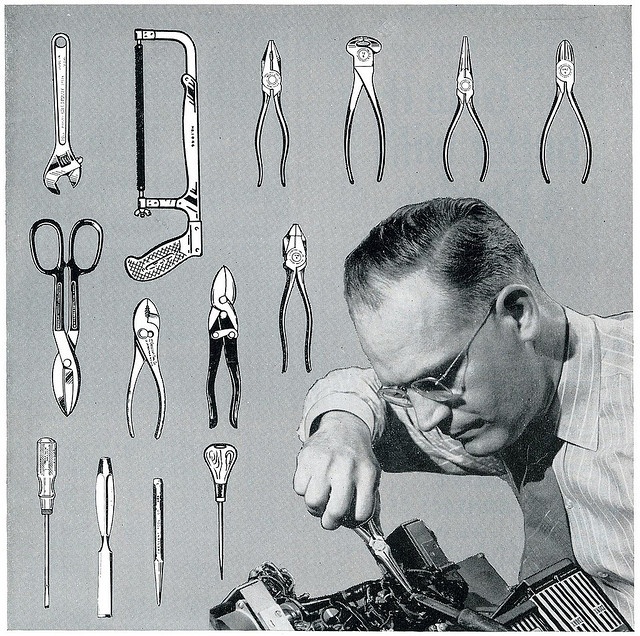
Oct
To Be a Woman Who Tinkers
[responsivevoice_button voice=”UK English Female” buttontext=”Listen to Post”]
To tweak, adjust, test, retest, ask, ask again, draw, redraw, rethink, reformat, reimagine, re-contextualize…is all basically tinkering. That is true in traditional graphic design, as it is in animation, interactivity, and web development. To be a tinkerer means to take on the challenge of something difficult even if it means taking longer than expected, arguing with other people, or being persistent. We celebrate these skills in men. Yet, it’s only in this century we are discovering that GASP! Women like to tinker too.

IKNOWRIGHT!?!??!
Video: GoldieBlox & Rube Goldberg “Princess Machine”
But when you’re a woman working in web design, web development, and digital animation, it seems expectations are different.
Recently, I experienced two separate instances in which I asked for technical advice/support about two separate projects. One was for a digital animation, the other for this site.
In the former I asked a skilled digital animator, about tips for smoother transitions. Instead I got a lecture about how my design could be more dynamic, and what I needed to do if I wanted to get noticed. Nevermind that I am at least ten years this person’s senior, dynamic was never my intent, and did not ask for a critique of my work; just technical advice. When I reminded them of context, they mustered enough humility to point me in the right direction.
”But if you’re a woman, the assumption is that you lack the intelligence or tenacity to work until the problem is solved. It’s as though our heads and hearts are too weak to endure the mental task of try, try again.
In the latter, I was working with a theme developer on blog images improperly rotating on mobile devices. During a private e-ticket I disagreed with what they suggested for this particular problem, as I thought it compromised security. Things quickly turned unfriendly. It wasn’t until I issued a public e-ticket I got a more clear, honest, and civil answer.
Both examples require digging deeper if the first answer didn’t work. Rather than focus on a solution, respondents seemed to see my credibility as up for scrutiny first. Meaning the degree to which the problem can be solved is relative — not to their ability to answer the question — but to my ability to actually solve the problem.
I’ve been working off and on in digital animation for over ten years. I’ve written code, troubleshooting it across several browsers; even written custom XML tags in Expression Engine. It’s still incredibly insulting to expect me to re-read my resumé to people when I have a tech question.
Not all experiences are bad. If I’m troubleshooting a theme from HTML5Up.net, I can tweet AJ, and get a clear answer. He or she will even respond positively to my take on their theme. When we worked with Social Driver to redesign Ed Trust’s website, they were so great to work with, even when there were challenges.
The singular instances are not the issue. It’s the pattern. And it’s exhaustive.
Caitie McCaffrey shares her path from building Halo to technical lead at Twitter. https://t.co/BT8oItHOIV pic.twitter.com/KE2qMd4udV
— techies (@techiesproject) July 18, 2016
The Trouble of Troubleshooting Code
If you’re a man, you’re expected to persevere when you problem-solve. Because at the end it will all be worth it, and inevitably you’ve solved the problem. But if you’re a woman, the assumption is that you lack the intelligence or tenacity to work until the problem is solved. It’s as though our heads and hearts are too weak to endure the mental task of try, try again.
At the same time it is discouraging to come from traditional graphic design community that can be distant — if not openly hostile — toward hands-on web development and design. A world where print reigns supreme, web site design can be disposable, and learning is seen as burdensome. It’s hard to find sympathetic ears when I complain of theme troubles or animation sequences. The sad reality is that many of these folks are women. Many will say,
Why don’t you just try another theme?
as though another theme won’t present their own inherent problems. Or,
You know, just hand it over to web developer.
But what if you are a web developer?
”Meaning the degree to which the problem can be solved is relative -- not to their ability to answer the question -- but to my ability to actually solve the problem.
Make no mistake: web development and animation is hard work. Problems used to arise due to browser, web font, or device dependency. Now, problems are about adapting animation and video to mobile experiences. You can be the most imaginative artist, storyboard a fantastic, dynamic sequence. Yet the digital tools available to even the most skilled animators are daunting, then lose relevance when technology improves. The failures are many. But the successes often come from several men and women coming together — and often bumping heads — to solve the problem.


